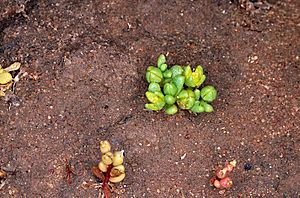Green pigface facts for kids
Gunniopsis septifraga, commonly known as green pigface, is a cool flowering plant from the iceplant family. It's special because it only grows in Australia! This plant is a small, low-growing annual herb with leaves shaped like tiny spears and little green flowers. You'll usually find it growing near salt lakes.
Quick facts for kids Green pigface |
|
|---|---|
 |
|
| Gunniopsis septifraga near Binnu | |
| Scientific classification | |
| Genus: |
Gunniopsis
|
| Species: |
septifraga
|
| Synonyms | |
What Does Green Pigface Look Like?
Green pigface is a small plant that grows low to the ground or in small clumps. It's an ephemeral plant, meaning it lives for only a short time, usually less than a year. It typically grows about 5 centimeters (2 inches) tall and spreads out about 15 centimeters (6 inches) wide.
Its stems are thick and yellow, and they can be smooth or have a few hairs. The leaves are shaped like oblongs or spears, about 5 to 15 millimeters (0.2 to 0.6 inches) long and 1 to 5 millimeters (0.04 to 0.2 inches) wide.
The flowers are small and greenish. They grow alone and don't have a stalk, or they might have a very short one. The flower's outer part, called the perianth, is about 2.5 to 6 millimeters (0.1 to 0.24 inches) long. It's green inside and greenish-yellow outside. There are usually four triangular parts to the perianth, and these often alternate with four stamens (the parts that produce pollen).
Green pigface flowers from July to October. After flowering, it produces a fruit called a capsule. This capsule is mostly round with a cylinder-shaped tip. Inside, you'll find wrinkled, white or clear, comma-shaped seeds.
How Green Pigface Got Its Name
This plant was first officially described in 1859 by a scientist named Ferdinand von Mueller. He called it Gunnia septifraga. He wrote about it in a report for the Parliament of Victoria, Australia. The first samples of the plant were collected near a place called "Stuart's Creek" by Joseph Herrgott.
Later, in 1867, another scientist named George Bentham described a similar plant, Gunnia drummondii. However, both Gunnia septifraga and G. drummondii were later reclassified. This means their names were changed and they were put into a different group.
In 1934, Ferdinand Pax and Käthe Hoffmann renamed them Neogunnia septifraga and N. drummondii.
Finally, in 1983, Robert Chinnock changed the name Neogunnia saxifraga to Gunniopsis saxifraga. He also decided that Neogunnia drummondii was actually the same plant as N. saxifraga. This is the name and grouping that scientists accept today.
The second part of the plant's scientific name, septifraga, is Latin. It means "to break." This refers to how the seed pod of the plant breaks open when it's ready to release its seeds.
Where Does Green Pigface Grow?
Green pigface loves very salty places! You'll find it growing around the edges and in the damp bottoms of salt lakes and salt pans. It often forms thick patches, sometimes growing near other plants like Tecticornia shrubs.
This plant grows in several parts of Australia. You can find it in the Mid West, Wheatbelt, and Goldfields-Esperance regions of Western Australia. It also grows in the dry, inland areas of the Northern Territory, South Australia, and New South Wales.

